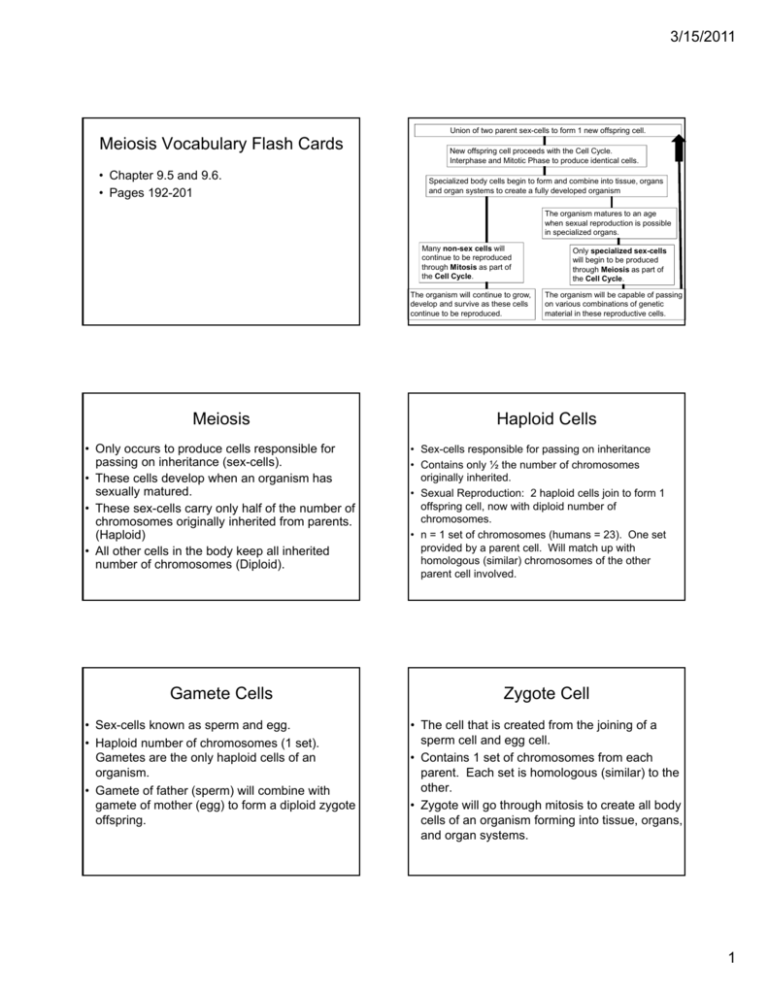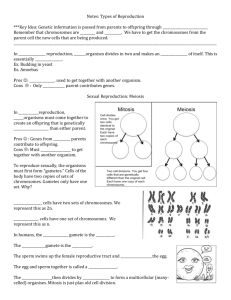Meiosis Vocabulary Flash Cards Meiosis Haploid Cells Gamete
advertisement

3/15/2011 Union of two parent sex-cells to form 1 new offspring cell. Meiosis Vocabulary Flash Cards • Chapter 9.5 and 9.6. • Pages 192-201 New offspring cell proceeds with the Cell Cycle. Interphase and Mitotic Phase to produce identical cells. Specialized body cells begin to form and combine into tissue, organs and organ systems to create a fully developed organism The organism matures to an age when sexual reproduction is possible in specialized organs. Many non-sex cells will continue to be reproduced through Mitosis as part of the Cell Cycle. The organism will continue to grow, develop and survive as these cells continue to be reproduced. Meiosis • Only occurs to produce cells responsible for passing on inheritance (sex-cells). • These cells develop when an organism has sexually matured. • These sex-cells carry only half of the number of chromosomes originally inherited from parents. (Haploid) • All other cells in the body keep all inherited number of chromosomes (Diploid). Only specialized sex-cells will begin to be produced through Meiosis as part of the Cell Cycle. The organism will be capable of passing on various combinations of genetic material in these reproductive cells. Haploid Cells • Sex-cells responsible for passing on inheritance • Contains only ½ the number of chromosomes originally inherited. • Sexual Reproduction: 2 haploid cells join to form 1 offspring cell, now with diploid number of chromosomes. • n = 1 set of chromosomes (humans = 23). One set provided by a parent cell. Will match up with homologous (similar) chromosomes of the other parent cell involved. Gamete Cells Zygote Cell • Sex-cells known as sperm and egg. • Haploid number of chromosomes (1 set). Gametes are the only haploid cells of an organism. • Gamete of father (sperm) will combine with gamete of mother (egg) to form a diploid zygote offspring. • The cell that is created from the joining of a sperm cell and egg cell. • Contains 1 set of chromosomes from each parent. Each set is homologous (similar) to the other. • Zygote will go through mitosis to create all body cells of an organism forming into tissue, organs, and organ systems. 1 3/15/2011 Diploid Cells • Original zygote cell and all body cells. • Contain total number of chromosomes inherited from 2 original parent cells. • 2n = 2 sets of chromosomes (humans = 46). One set from a parent will match up with the other parent’s homologous chromosomes. Tetrad (set of 4) • Duplicated sets of homologous chromosomes. • During Interphase of cells within the sex organs, the homologous chromosomes from each parent will duplicate during S phase. • This creates enough genetic material to eventually form into 4 haploid sex-cells. Homologous Chromosomes • The chromosomes inherited from two parents have similar genes. • Ex: A chromosome from the father that contains the gene for eye color will match up with the same type of chromosome from the mother. This occurs in the nucleus. Crossing over • Involves homologous chromosome tetrads in a sexcell. • Genes from homologous chromosomes will be traded or mixed. • This creates new, unique versions of chromosomes known as genetic recombination. • These new chromosomes still have inherited genes, but in a different arrangement. • The eventual separation of homologous chromosomes into 4 new sex-cells will cause the next offspring to have a unique arrangement of characterisics. Genetic Recombination • Results from the crossing over of genes between homologous chromosomes inherited from parents. • 1 sex-cell will be divided into 4 new gametes. • Each gamete will have a rearrangement or (recombination) of genes. • Recombination of original genetic material causes the offspring to be unique, but still show characteristics of parents. 2








